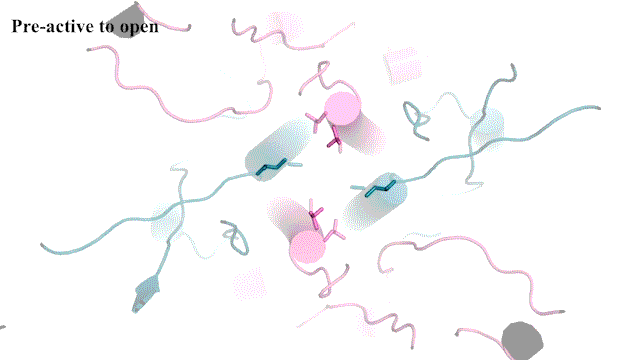
This protein does “The Twist”
Proteins are constantly performing a kind of dance. They move and contort their bodies to fulfill specific functions inside our bodies. The NMDAR protein executes an especially hard dance routine in our brains. One wrong step can lead to a range of neurological disorders. NMDAR binds to the neurotransmitter, glutamate, and another compound, glycine. These bindings control NMDAR’s dance steps. When their routine is over, the NMDAR opens. This open ion channel generates electrical signals critical for cognitive functions like memory.
The problem is that scientists couldn’t figure out the last step in NMDAR’s routine—until now. Cold Spring Harbor Laboratory Professor Hiro Furukawa and his team have deciphered the critical dance move in which NMDAR rotates into an open formation. In other words, they’ve learned the NMDAR “Twist.”
To capture this key step, Furukawa and his team used a technique called electron cryo-microscopy (cryo-EM), which freezes and visualizes proteins in action. First, the team had to find a way to keep a type of NMDAR called GluN1-2B in its open pose long enough to image it. So, Furukawa teamed up with Professors Stephen Traynelis and Dennis Liotta at Emory University. Together, they discovered a molecule that favors NMDAR in an open position.

“It’s not the most stable conformation,” Furukawa explains. “There are many pieces dancing independently in NMDAR. They have to coordinate with each other. Everything has to go perfectly to open the ion channel. We need a precise amount of electrical signals at the right time for proper behaviors and cognitions.”
The cryo-EM images allow researchers to see precisely how the NMDAR’s atoms move during its “Twist.” This may one day lead to drug compounds that can teach the correct moves to NMDARs that have lost a step. Better drugs that target NMDARs might have applications for neurological disorders like Alzheimer’s and depression. Furukawa explains:
“Compounds bind to pockets within proteins and are imperfect, initially. This will allow us and chemists to find a way to fill those pockets more perfectly. That would improve the potency of the drug. Also, the shape of the pocket is unique. But there could be something similarly shaped in other proteins. That would cause side effects. So, specificity is key.”
Indeed, there are many types of NMDARs in the brain. Another recent study from Furukawa’s lab offers the first view of the GluN1-3A NMDAR. Surprisingly, its dance moves are completely different. This routine results in unusual patterns of electrical signals.
In other words, we’re mastering the Twist.
Enjoy reading ASBMB Today?
Become a member to receive the print edition four times a year and the digital edition monthly.
Learn moreGet the latest from ASBMB Today
Enter your email address, and we’ll send you a weekly email with recent articles, interviews and more.
Latest in Science
Science highlights or most popular articles

The science of staying strong
Muscles power every movement, but they also tell the story of aging itself. Scientists are uncovering how strength fades, why some species resist it and what lifestyle and molecular clues could help preserve muscle health for life.

Bacteriophage protein could make queso fresco safer
Researchers characterized the structure and function of PlyP100, a bacteriophage protein that shows promise as a food-safe antimicrobial for preventing Listeria monocytogenes growth in fresh cheeses.

Building the blueprint to block HIV
Wesley Sundquist will present his work on the HIV capsid and revolutionary drug, Lenacapavir, at the ASBMB Annual Meeting, March 7–10, in Maryland.

Gut microbes hijack cancer pathway in high-fat diets
Researchers at the Feinstein Institutes for Medical Research found that a high-fat diet increases ammonia-producing bacteria in the gut microbiome of mice, which in turn disrupts TGF-β signaling and promotes colorectal cancer.

Mapping fentanyl’s cellular footprint
Using a new imaging method, researchers at State University of New York at Buffalo traced fentanyl’s effects inside brain immune cells, revealing how the drug alters lipid droplets, pointing to new paths for addiction diagnostics.

Designing life’s building blocks with AI
Tanja Kortemme, a professor at the University of California, San Francisco, will discuss her research using computational biology to engineer proteins at the 2026 ASBMB Annual Meeting.

